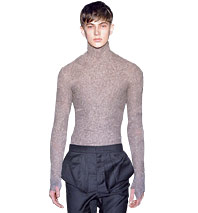 |
Models dress backstage at Emporio Armani.
(Photo: FirstView) |
During the summer of 2006, I went through a reinvention phase. I was tired of being slouchy and skinny, with forearms that looked like a pair of wooden drumsticks. So I started lifting weights. One night, in a crowded basement club, a fashion editor friend noticed me adjusting my posture.
“What are you doing?” he asked.
“I’ve been trying to stand up straight lately. I hate my schlumpy shoulders.”
“Don’t do that,” he said. “And stop lifting weights. Your look is what everybody wants, trust me. Keep sucking in your cheeks.”
It was one of those observations that kind of felt like an insult, like when someone sees you and says, “Oh, you got a haircut!” But my cultured friend was right: Scrawny and pale is the look in snooty fashion circles, as a result of a growing trend among designers over the past decade. Chicken legs, unite!
 |
A waif-boy at Raf Simons.
(Photo: FirstView) |
During the menswear shows in Milan, Paris, and New York this year, the size of male models took a drastic plunge. Hedi Slimane has cast waifs for his Dior Homme shows for years, and Raf Simons practically invented the look nearly a decade ago, but this year, we saw gaunt men coming down the runway for huge familiar labels like Gucci, Burberry, Thom Browne, Hermès, and Fendi.
Those sunken cheeks! Those girlish calves! That space between the thighs! (Perfect for your iPhone!) Are these boy-men really the wave of the future? Will the world soon be populated only by men in tight pants wobbling around looking for a pint of beer and a rice cake? (In this scenario, everyone dies out because there’s no way crotches so snug are good for the mechanics of reproduction.)
If so, it would be a great advantage for those of us who are naturally skinny and already enjoy eating celery. But it’s not going to happen. This particular look is a reflection of the product that the designers (Miuccia Prada and Simons particularly) are trying to sell. It’s not how most men want to look—American men, at least.
This iteration of the little boy motif has existed for a decade or two. It came from a mix of German street culture, British rock and roll, and American hipsterism. If you walk around at night on Rivington Street, for example, it does indeed look like someone had a Halloween party and everybody’s costume was “skinny.” Sprite-like boys skip from bar to bar, pouting and clutching cigarettes like they are sour candies. People call this carefully crafted elfin look “androgynous,” but it’s really more prepubescent. The guys on Delancey Street with their cuffs at mid-calf don’t look womanly like Scarlett Johansson. They look like Natalie Portman, duh.
As vibrant as it may be downtown, the trend hasn’t spread outside of a small social sector of big urban centers. These men—and the stylish European ones who actually buy expensive designer clothes—are directly influenced by fashion. They look at the models on the runway and in ads and think, “Oh, cheekbones. Why didn’t I think of that!?” But the truth is, most other men don’t care about models or want to be like them. They probably can’t even name one. (Not unless you count “Skinny McNoButt.”) Their effect on mainstream body image and apparel is minimal.
Although high fashion will probably be caught in this rut for a while, clothes for the ultrathin won’t necessarily be in mainstream stores. American menswear is generous, it’s healthy, and it’s comfortable. It’s Phat Farm and Ralph Lauren’s “American Living” collection at JCPenney.
Nonetheless, am I going to use this trend as an excuse to keep slouching and skip the gym? You bet I am. Just as soon as I figure out how to walk in these pants.

